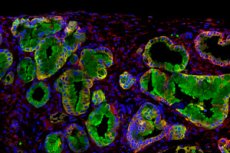New publications
Antibacterial protein is a new target for pancreatic cancer treatment
Last reviewed: 02.07.2025

All iLive content is medically reviewed or fact checked to ensure as much factual accuracy as possible.
We have strict sourcing guidelines and only link to reputable media sites, academic research institutions and, whenever possible, medically peer reviewed studies. Note that the numbers in parentheses ([1], [2], etc.) are clickable links to these studies.
If you feel that any of our content is inaccurate, out-of-date, or otherwise questionable, please select it and press Ctrl + Enter.

Immunotherapy represents a new hope in the fight against cancer, but not all tumors respond to this treatment. Pancreatic cancer is a type of tumor that does not respond to currently approved drugs and is therefore fatal for 9 out of 10 people diagnosed.
For this reason, it is necessary to find new targets to attack resistant cells, such as cancer stem cells, which are mainly responsible for tumor initiation, metastasis formation and treatment resistance.
A recent study by the Spanish National Research Council (CSIC), published in the journal Gut, describes how pancreatic cancer stem cells use the antibacterial protein PGLYRP1 to evade the immune system and protect themselves from early destruction.
When this protein is removed, the body's defense mechanisms are able to recognize tumor cells and destroy them. This will allow the development of new immunotherapies that will target the root cause of pancreatic cancer and lead to better treatments in the future.
The study was jointly conducted by three scientists: Bruno Sainz, head of the Cancer Stem Cells and Fibroinflammatory Microenvironment Group at the Biomedical Research Institute of Sols Morreale (IIBM), CSIC-UAM, and the Biomarkers and Personalized Approach to Cancer Treatment (BIOPAC) Group at the Ramon y Cajal Institute for Health Research (IRYCIS); Christopher Heschen from the Candiolo Cancer Institute (IRCCS) in Italy, and Susana García Silva, a scientist at the Spanish National Cancer Research Centre (CNIO).
Over the past decade, the three scientists have been working together on a project in which they have identified a population of pancreatic cancer stem cells (CSCs) present in mouse models of the disease. These cells, known as the tumor core, are responsible for disease recurrence following treatment with chemotherapy or radiotherapy.
Interestingly, pancreatic cancer is also one of the most resistant tumors to immunotherapy. However, until now, the mechanisms by which CSCs evade destruction by the immune system have remained unclear.
As a result of this collaboration, peptide glycan recognition protein 1 (PGLYRP1) was identified as one of the reasons why CSCs evade the immune system using sophisticated mouse models and patient samples. This work is the first to describe the role of this protein, which is overproduced in stem cells, in pancreatic cancer. This discovery lays the groundwork for developing treatments against it.
Potential Therapy for Root Cause of Pancreatic Cancer
“When we remove PGLYRP1 from tumor cells, we see that the immune system responds by attacking them, preventing the formation of a primary tumor and metastatic spread,” explains Sainz, a group leader at IIBM. “We are now developing therapies to block or eliminate this protein, with the hope of being able to combine them with current treatments to more effectively attack and eliminate cancer stem cells, the root of the tumor,” he adds.
Over the past four years, Juan Carlos Lopez-Gil, the first author of the paper, has been able to decipher why CSCs produce this protein in pancreatic cancer. He says: “We saw that immune cells try to destroy tumor cells by producing tumor necrosis factor, but PGLYRP1 is very similar to this factor and interacts with the same receptor, blocking it.”
For the researcher, this means that “CSCs defend themselves by using an incomplete key (PGLYRP1) to lock the padlock (the receptor) and thereby avoid tumor necrosis factor-induced death (the complete key).”
What’s surprising to the researchers is that a protein used by our immune system to fight bacteria is used by pancreatic cancer to thwart those same defenses. “The priority going forward will be to understand the mechanisms by which tumor cells hijack physiological processes to ‘re-educate’ the tumor environment and make it react against them,” says co-author Garcia-Silva.
